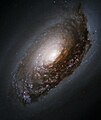Податотека:Blackeyegalaxy.jpg

Големина на овој преглед: 505 × 600 пиксели. Други разделности: 202 × 240 пиксели | 404 × 480 пиксели | 897 × 1.065 пиксели.
Изворна податотека (897 × 1.065 пиксели, големина: 774 КБ, MIME-тип: image/jpeg)
Историја на податотеката
Стиснете на датум/време за да ја видите податотеката како изгледала тогаш.
| Датум/време | Минијатура | Димензии | Корисник | Коментар | |
|---|---|---|---|---|---|
| тековна | 11:46, 2 јуни 2005 |  | 897 × 1.065 (774 КБ) | CWitte | This image of M64 was taken with Hubble's Wide Field Planetary Camera 2 (WFPC2). The color image is a composite prepared by the Hubble Heritage Team from pictures taken through four different color filters. These filters isolate blue and near-infrared lig |
Употреба на податотеката
Податотекава се користи во следниве 4 страници:
Глобална употреба на податотеката
Оваа податотека ја користат и следниве викија:
- Употреба на af.wikipedia.org
- Употреба на ar.wikipedia.org
- Употреба на ast.wikipedia.org
- Употреба на az.wikipedia.org
- Употреба на be.wikipedia.org
- Употреба на bg.wikipedia.org
- Употреба на bn.wikipedia.org
- Употреба на br.wikipedia.org
- Употреба на bs.wikipedia.org
- Употреба на ca.wikipedia.org
- Употреба на ce.wikipedia.org
- Употреба на ckb.wikipedia.org
- Употреба на co.wikipedia.org
- Употреба на cs.wikipedia.org
- Употреба на cy.wikipedia.org
- Употреба на de.wikipedia.org
- Употреба на diq.wikipedia.org
- Употреба на el.wikipedia.org
- Употреба на en.wikipedia.org
- Messier object
- Coma Berenices
- List of galaxies
- Portal:Astronomy/Picture/May 2005
- Portal:Astronomy/Picture/12 May 2005
- Portal:Astronomy/Picture/Week 48 2005
- User:ComaDivine
- User:Superfo
- User:Gilgamesh~enwiki/Favorite images
- List of spiral galaxies
- Portal:Solar System
- Portal:Solar System/WikiProjects
- User:Passargea/Favourite pictures/Space
- User:Logos/Hall of Galaxies
- User talk:Example/Archives/2008/April
- User:Mike YuHong Chen
- User:Stefania.deluca/sandbox
Погледајте ја останатата глобална употреба на податотекава.

